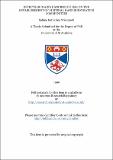Files in this item
Effects of marine microfouling on the establishment of subtidal hard substratum communities
Item metadata
| dc.contributor.advisor | Todd, Christopher David | |
| dc.contributor.author | Wieczorek, Sabine Katharina | |
| dc.coverage.spatial | 328 p. | en_US |
| dc.date.accessioned | 2018-06-07T13:46:50Z | |
| dc.date.available | 2018-06-07T13:46:50Z | |
| dc.date.issued | 1996 | |
| dc.identifier.uri | https://hdl.handle.net/10023/13820 | |
| dc.description.abstract | Sessile marine invertebrate larvae can recognize suitable settlement substrata by using various environmental cues, including organic/microbial "biofilms". In laboratory assays the effect of biofilm age on the settlement of a range of fouling species was assessed: the species included barnacle, bryozoan, spirorbin and ascidian larvae. The larvae of most species responded differentially to films of varying ages. A general trend of reversal of the effect of filming on the settlement response of the barnacle Balanus amphitrite amphitrite- from inhibitory to facilitatory - was noted with increasing film age. The settlement of the solitary ascidian Ciona intestinalis clearly was facilitated on filmed substrata of all ages. The larvae of the arborescent bryozoan Bugula flabellata generally were inhibited by biofilming (irrespective of film age), and the settlement of the polychaete Spirorbis spirorbis was found to be enhanced on "older" (12d) films only. In a series of manipulative panel experiments in a tidal rapid on the west coast of Scotland the effects of biofilming on subsequent larval settlement in the field were quantified. Inhibitory and facilitatory responses to biofilming were noted and these varied markedly between species and between two local habitats of contrasting flow regimes. The larvae of certain year-round settling species were found to vary in their response to biofilmed substrata depending on the season. Quantitative data were obtained for biofilms on artificial substrata by enumerating bacteria, diatoms, protozoans, fungi and the percent cover of microbial exopolymeric substances. These permitted comparisons of biofilms both in field and laboratory experiments. The results of the present study emphasize the importance of microbial surface film cues in explaining recruitment patterns of macrofouling assemblages during the first stages of substratum colonization. | en_US |
| dc.language.iso | en | en_US |
| dc.publisher | University of St Andrews | |
| dc.subject.lcsh | Marine fouling organisms | en |
| dc.title | Effects of marine microfouling on the establishment of subtidal hard substratum communities | en_US |
| dc.type | Thesis | en_US |
| dc.contributor.sponsor | Deutscher Akademischer Austauschdienst (DAAD) | en_US |
| dc.contributor.sponsor | Deutscher Akademikerinnenbund | en_US |
| dc.contributor.sponsor | Buntstift e.V. | en_US |
| dc.contributor.sponsor | Russell Trust | en_US |
| dc.contributor.sponsor | Marine Biological Association of the United Kingdom | en_US |
| dc.type.qualificationlevel | Doctoral | en_US |
| dc.type.qualificationname | PhD Doctor of Philosophy | en_US |
| dc.publisher.institution | The University of St Andrews | en_US |
This item appears in the following Collection(s)
Items in the St Andrews Research Repository are protected by copyright, with all rights reserved, unless otherwise indicated.

